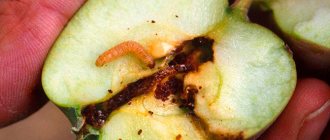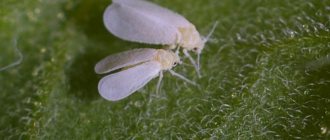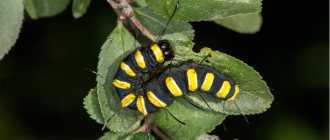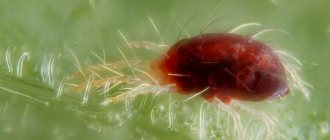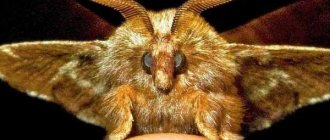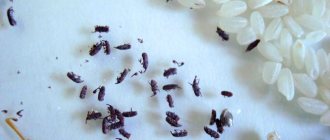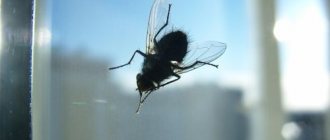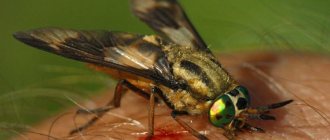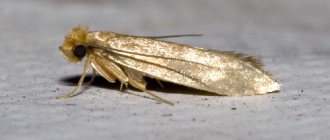Home / Pests and diseases
Back
Published: 06/09/2019
0
Rate this post
Caterpillars appear when butterflies lay eggs. These small caterpillars are very voracious by nature. In addition, they are unpretentious to environmental conditions. Caterpillars eat the leaves, fruits and flowers of apple trees with equal success, no matter what the weather is, and they do this from early spring to late autumn. If you don't fight them, the worms will completely destroy the apple tree.
In most cases, they are easy to detect; to do this, carefully inspect the tree. Almost all types of caterpillars are large enough to be noticed.
In our area, the most common species found are ermine moths, moths, ringed and gypsy moths, and hawthorn. The most noticeable are the silkworm larvae. The length of their shaggy body reaches seven centimeters in length.
Hawthorn looks much more modest. This black caterpillar is smooth and very small. It's harder to notice.
Such an insidious parasite as a moth larva can generally be detected only by eating leaves, the larvae are so small. If you do not start an urgent fight against the caterpillars on the apple tree, then these “invisible insects” will very quickly multiply and completely deprive the tree of foliage, flowers and ovary.
- 1 Consequences from the pest
- 2 How to get rid of caterpillars on an apple tree
- 3 How to deal with codling moth
- 4 How to treat an apple tree against leaf roller caterpillars
- 5 Traditional methods of struggle
- 6 Chemicals
- 7 Prevention
Consequences from the pest
Initially, the caterpillars hide under the bark of apple trees. At this time, it is difficult to detect them. Meanwhile, they carry out their harmful activities under the bark. Caterpillars are able to gnaw channels in a tree trunk, which contributes to the appearance of fungal diseases, which are much more dangerous for apple trees.
The caterpillars cause the greatest damage when gardens are in flower. They eat buds and ovaries. Luckily, they are easiest to spot on flowers. Apple blossoms are most readily consumed by leaf rollers, codling moths and hawthorns.
It is worth saying that the leaf roller caterpillar also affects gooseberries, pears, currants and garden flowers.
How to get rid of caterpillars on an apple tree
In order to successfully fight black and any other caterpillars on an apple tree, you need to take preventive actions and determine what kind of pest is on the tree. If you find gray caterpillars, it means they are hawthorns. If a cobweb has formed on the foliage or branches, this indicates that an apple moth has appeared in the crown of the tree. The presence of leaf rollers on an apple tree causes the leaves to curl.
Preventive actions include spring whitewashing of trunks with lime mortar, timely pruning of branches, proper and regular fertilizing and, of course, watering on dry days. This work should be carried out regularly from early spring to late autumn, then caterpillars will not appear on the leaves of the apple tree.
Useful tips
Don't think that a few leaves on a tree don't matter and you can ignore their infestation. The entire tree functions as a full-fledged organism, so damage to any of its organs will cause a weakening of the immune system.
And the impact of caterpillars on apple trees should not be underestimated either. They multiply quickly and eat various parts of the tree, causing irreparable damage to it. Even if they are not present at the moment, it is better to periodically check the crown, because they can appear completely by accident and quickly begin to act.
Sources
- https://ydoo.info/qa/kak-izbavitsya-ot-gusenic.html
- https://GdeKlop.ru/babochki/obrabotat-kusty/
- https://yabloki.site/sovety-sadovodam/vrediteli/guseniczy-na-yablone-kak-borotsya
- https://DachaMechty.ru/yablonya/gusenitsy-kak-borotsya.html
- https://NaYablone.ru/bolezni-i-vrediteli/gusenicy-na-yablone
- https://bezbukashek.ru/drugie/metody-borby-s-gusenicami-na-sadovom-uchastke-luchshie-narodnye-sredstva
- https://frukti-yagodi.ru/boremsya-s-gusenicami-na-yablokah/
- https://www.ogorod.ru/ru/now/pests/13403/Borba-s-gusenicami-v-sadu-i-ogorode-chem-obrabatyvat-rastenija.htm
- https://Green-design.pro/stati/uhod-za-sadom/kak-borotsya-s-gusenitsami-na-yablonyah/
- https://pro100ogorod.ru/yablonya/pautina.html
- https://7ogorod.ru/plodovye-derevya/gusenicy-na-ablone-v-pautine-kak-borotsa.html
- https://sadsezon.com/sad/plodovie/yabloni/vrediteli/gusenitsy.html
- https://2sotki.ru/gusenicy-na-ablone-v-pautine-kak-borotsa.html
[collapse]
How to fight the codling moth
The codling moth is very common in our gardens. Its pupae spend the winter in the soil near the trunks of apple trees. With the onset of spring, butterflies emerge from the pupae and lay eggs on the leaves of the apple tree. It is difficult to see them; they are extremely small. In early summer, tiny worms hatch from these eggs. These are the caterpillars of the moth. They feed on the core of the fruit, rendering it unusable. Under their influence, unripe apples fall. How to treat apple trees in June?
To successfully combat the pest, first of all, collect all fallen apples and destroy them. Adhesive catching belts, which are attached to apple tree trunks below the very first branch, have proven to be very effective.
After the apple tree has finished flowering, treat it with insecticidal preparations. This is a solution of chlorophos (0.2%) or karbofos (0.3%). Experienced gardeners first spray one tree and watch it for a day. If nothing bad happened to the apple tree, then the remaining trees are treated.
Source of cobwebs and signs of apple tree damage
If cobwebs appear on the apple trees, this is a sign that the trees have been attacked by pests. Most often these are different types of caterpillars. If a problem is detected, it is necessary to immediately treat the apple tree, otherwise you may be left not only without a harvest, but also lose the fruit tree. What insects can cause cobwebs to appear on an apple tree and how to fight them, this will be discussed.
Apple moth
This pest of fruit trees is known to gardeners as the ermine moth. Caterpillars are dangerous for apple trees. Their ability to protect themselves from frost with shields allows insects to survive the cold, and when temperatures above zero, pests become more active. The caterpillars intensively feed on greenery for almost a month and a half; the gnawed leaves curl and dry. And then the pest pupates in a nest formed from cobwebs.
After a couple of weeks, a small silver-white butterfly appears and lays several dozen eggs covered with a protective shield. The butterfly creates a clutch on the bark of young tree branches.
If the apple tree is not treated in a timely manner, the pest can destroy a young seedling and even an adult tree. Deprived of foliage, entangled in cobwebs, apple trees produce a depressing sight, and often do not tolerate frosty winters.
Winter moth
A brown-gray butterfly with underdeveloped wings that cannot fly is a female winter moth. The harmful insect destroys up to half the leaves on the tree, and affects fruit trees (pears, apple trees) and most other deciduous trees.
The emerging bright yellowish-green caterpillars with a dark stripe on their back very quickly destroy tender buds and fresh green leaves. The caterpillars are active for a month, then they descend along the web woven in the leaves, pupate, climbing underground in the area of the tree trunk, and wait for autumn.
Gypsy moth
Butterflies belong to the moth family. Females are distinguished by a thick cylindrical abdomen and white wings. Males have light brown wings with dark patterns and a thin abdomen. Individuals are active in the evening. Males fertilize females sitting on the bark of trees, who lay a huge number of eggs on the bark. There can be up to 1000 of them in a clutch.
In the spring, caterpillars emerge from the eggs, the large bristles of which allow them to be carried over considerable distances by gusts of wind. The small caterpillar is yellow, the adult is dark, almost black. The gypsy moth destroys the buds, leaves, and flowers of the plant. The development period of the caterpillars takes 30-50 days, during which time they destroy deciduous trees over a wide area and then pupate.
Ringed silkworm
Butterflies of this species are also called ringed cocoon moths. Females are much larger than males. All individuals are colored in shades of brown; depending on the region of distribution, they can be light or dark in color.
For laying eggs, the butterfly prefers young thin branches, arranging the eggs in an even ring.
The caterpillars are large, up to 5.5 centimeters in length, with bright multi-colored (white, blue, orange) stripes and bristles characteristic of silkworms. They appear during the period of swelling of the buds, destroy them and young leaves, while forming huge clumps of cobwebs.
Apple wormwood
The name psyllid that this insect has is due to the small size of the pest. It is greenish in color, with transparent wings, and about 3 millimeters long. By the end of the summer season, individuals become darker. The insect lays eggs in folds of the bark, on the bud bases. In the spring, larvae emerge from them, which, as they grow, are capable of destroying all parts of the apple tree (buds, greens, even young bark).
Spider mite
A small arthropod insect from the arachnid family. Individuals are up to 1 millimeter, transparent, greenish in color, becoming red or brown over time. Pests feed on plant sap. They reproduce especially actively in dry, hot weather. These pests are capable of attacking trees of different species. When spider mites spread in the garden, and the weather is favorable for them, all trees and shrubs become covered with cobwebs.
Spider aphid
This pest appears along with the spider mite. Aphids quickly attack young, succulent parts of the apple tree. It also feeds on plant sap; leaves affected by the pest first swell, changing color, and then dry out.
How to treat an apple tree against leaf roller caterpillars
Green caterpillars emerge from the eggs of leaf roller butterflies. They love apple buds when they are still young, then they switch to flowers, and then to leaves. The waste products of leaf roller caterpillars look like cobwebs. Under its influence, the leaves curl into tubes, inside which the caterpillar lives.
How to deal with apple tree pests? Mechanically. Tear off all curled leaves and burn. If in the spring there are too many of these pests on the tree, then before flowering, spray the apple tree with a 3% solution of nitrafen. Repeated treatment can be done no earlier than two weeks later.
Apple (pear) psyllid
This winged “snake” itself shyly feeds on pollen, but its offspring - larval caterpillars suck plant juices from flowers, leaves, buds and young bark.
When feeding, the caterpillars secrete specific sticky excrement that resembles cotton candy in appearance. This “cotton wool” glues together the leaves and flowers of fruit trees and shrubs, allowing sooty fungi to grow comfortably. These parasitic mushrooms look like a dense white web on the leaves and branches, although they have nothing to do with the real web.
Folk methods of struggle
Gardening goes back thousands of years and, of course, during this time people have come up with many folk remedies for killing caterpillars on apple trees.
Washing off the caterpillars with a tight stream of water is a fairly effective method. Of course, all caterpillars need to be collected from the ground and destroyed.
Black caterpillars can be successfully combated by shaking the branches of apple trees. These insects practically do not stick to leaves or branches and immediately fall to the ground even with gentle shaking. Before doing this, you need to spread a film on the ground so that the parasites can be easily collected and burned.
If you plant tomatoes between the rows of apple trees, the smell of their tops will repel caterpillars.
Glue belts on the trunks of apple trees will prevent the larvae from reaching the crown.
In early June, apple trees can be sprayed with a rich decoction of pine needles, celandine, tansy or burdock. Caterpillars cannot stand their smell. Two weeks after the end of flowering, it would not hurt to repeat this treatment again.
The caterpillars also do not tolerate the smell of tomato tops decoction.
A decoction of wormwood or yarrow also helps get rid of caterpillars.
No less effective methods of combating caterpillars are solutions of baking soda, vinegar or laundry soap. You can use ash instead of baking soda.
Traditional recipes have one drawback. They need to be alternated, since caterpillars are able to adapt to a specific means. You can treat apple trees with these products at intervals of one week.
Spider aphid
As a rule, aphids appear simultaneously with spider mites. The pest reproduces very quickly - the female is capable of laying up to 100 larvae at a time.
Methods for controlling green aphids
Green aphids choose young trees. The insect sucks juices from fruits, branches and foliage using its proboscis, causing the leaves to curl and fall off. Another sign of the presence of green aphids is a black coating on the trunk.
To remove it, apple trees are sprayed with tobacco infusion.
Methods for controlling gray aphids
The gray one settles mainly on mature trees. A symptom of the pest is swollen foliage that has changed color. Subsequently, the leaves curl and dry.
They get rid of aphids of this species using bioinsecticides (Verticillin, for example). Processing begins when the air temperature is set at 22-24 °C. Dissolve 100-500 ml of the product in water and spray.
After treatment with the solution, the top layer of bark is peeled off and the trunk is covered with whitewash. Special traps are attached to the trunk - belts made of thick paper or straw. The pest lays eggs in them, and at the end of autumn the belts are removed and burned.
Chemicals
The use of chemicals to combat caterpillars is a last resort when it is impossible to get rid of them by other means. Here we are talking about the use of poisons. Use chemicals strictly according to the instructions, which are always printed on the packaging. You need to work with them wearing protective clothing, rubber gloves and goggles. Be sure to use a respirator.
- Intavir is available in tablet or powder form. No more than three treatments per season are allowed.
- Tanrek is a systemic drug. The product has a detrimental effect on caterpillars within three weeks. It can be used only before the apple trees begin to bloom and after the harvest is completed.
- Karbofos and Fufanon. Both drugs have a contact method of influencing caterpillars. Under their influence, insects' digestive systems are paralyzed and they die of hunger. The insecticides contain malathion, which lasts ten days in the absence of rain. These products can only be used during the growing season of apple trees, no later than 3 weeks before the start of apple picking. No more than two sprayings are allowed in one season.
- Fitoverm does not contain chemical toxic substances; it is a biologically active means of combating insects. One ampoule is designed for 2.5 liters of water. You cannot spray apple trees with this product during flowering.
General recommendations
Having considered how to deal with cobwebs on trees, several important points should be noted:
- It is necessary to apply insecticides strictly according to the instructions, trying to choose a dry, windless day for this. Otherwise, the plant will not receive proper protection and will not be able to develop and bear fruit normally. The parasite larvae that have settled in the cocoons will mercilessly destroy young buds and fruit ovaries, and in the future the web will grow throughout the entire crown. In addition, eggs and caterpillars will successfully survive the winter in their cozy warm cocoons and with the arrival of spring they will begin to bite into the juicy foliage and destroy the pulp of the fruits.
- If this year you carried out several treatments, doing everything according to the rules, then next spring you need to carefully inspect the trees again and remove spider nests. Surviving caterpillars may be hiding in them, which, with the arrival of warmer weather, will wake up and begin to actively reproduce.
- If the infection is minor, but you are unable to reach the upper part of the crown, which is entangled in cobwebs, then you also need to resort to the help of acaricidal agents. It is quite possible that in this case only two treatments will be sufficient. Use one of the suggested remedies twice a season at intervals of a week.
And do not forget that with frequent treatment with the same drug, insects may develop resistance (immunity). And to prevent this from happening, try to regularly change the insecticide, while paying special attention to the main active ingredient - it is it, and not the name of the product, that should be different. Have a good harvest!
Prevention
- Inspect apple trees regularly to detect harmful insects and their larvae.
- In the spring, destroy all egg-laying and spider nests found on the tree, and also whiten the trunks with lime mortar
- Throughout the season, pluck and burn all the leaves rolled into a tube.
- Periodically spray the soil under apple trees with endobacterin.
- Don’t be lazy to spray apple trees with folk remedies against caterpillars.
- Place several feeders in the garden for birds that eat caterpillars.
If you follow the entire complex of the above measures, then caterpillars will not appear on your apple trees, which means that you will definitely reap a good harvest of tasty apples.
Rate this post
Timing of preventive treatments
Prevention measures are organized in the spring. The gardener needs to carefully spray and inspect the bark, get rid of nests covered with cobwebs and damaged leaves. It will be necessary to bleach the trunks and treat the tree and the soil around it with a biological product. And it is recommended to attract natural helpers. Bird feeders will do this job perfectly. This way you can provide apple trees with protection and future harvests.
Before the start of sap flow
The buds of the apple trees have not yet woken up, but the time has come for spring work: inspecting the trees after winter days, destroying all traces of caterpillars.
From start to finish of flowering
From the moment the buds hatch until the flowers appear, it is time to spray the apple trees with copper sulfate and insecticides. Otherwise, the caterpillars will damage the flowers and ovaries. When flowering begins, spraying is stopped. Only manual collection and burning of caterpillars is available. You can spray trees with Bordeaux mixture if spraying has not been done before.
After flowering
As soon as flowering has completed, the next treatment of apple trees against codling moths is carried out. Both folk remedies and insecticides are used. From this moment until the apples ripen, there should be at least a month left.
When apples ripen
Chemicals are no longer used. Manual collection is used to destroy caterpillars.
After fruiting
The time has come to prepare apple trees for winter: collect and burn fallen leaves, dig up the ground, and then treat them with insecticides. Sanitary pruning of apple trees will be required, and, if necessary, wound treatment. Tree trunks are whitened for the winter.
Caterpillars, even the smallest ones, can cause great damage to trees. If you leave everything as it is, the apple tree will wither, and the yield will disappear over time. If you know about ways to combat apple tree pests, you can prevent their occurrence. And then the apple orchard will delight its owners with fabulous harvests every year.
